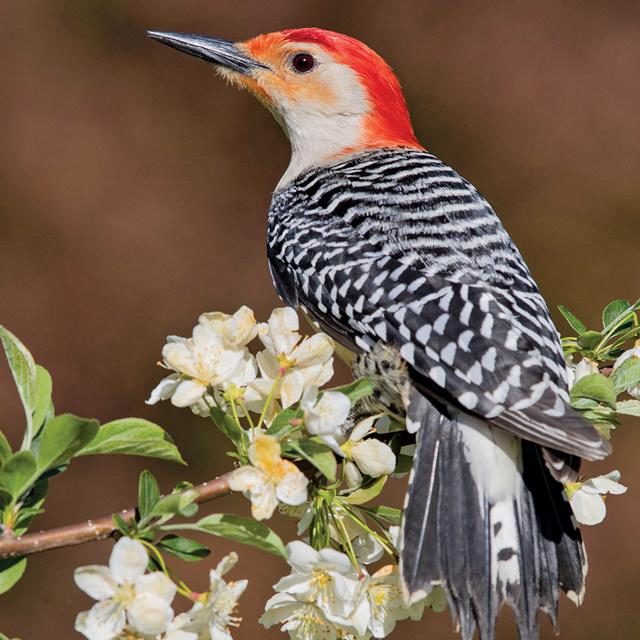Among the avian neighbors who regularly dine at our backyard feeders, the male red-bellied woodpecker is among the most cheerfully elegant, his long, black-and-white patterned coat finished off at the bottom with a fine barred tail. With his whitish shirt, he needs only a white bowtie and waistcoat to be fully decked out in formal evening attire. He compensates by sporting an incredibly bright red cap that continues down and covers the nape of the neck. Especially in these times, it is uplifting to see this red-bellied bird making a dramatic entrance into the backyard, his costume silently shouting “Laissez les bons temps rouler!”
The female’s outfit is pretty much the same, but she does dress down a little; those wonderful red feathers appear just at her nape.
The red staining on the lower part of the abdomen is sometimes hard to see; according to city ornithologist Juliet Berger, sometimes it is not even red and sometimes it is not there at all.
The “red-headed” woodpecker is another bird whose entire head is red. The speculation is that the red-bellied ended up with its name because the red-headed title had already been claimed. Berger asks that people use the correct common name when referring to the red-bellied woodpecker. Calling it “red-headed” could introduce errors in important bird count statistics–as well as sparking fruitless investigations by birders hoping to spot the now locally rare red-head.
The red-headed woodpecker may have won the naming contest, but it has lost something more important: its territory. Red-bellies are expanding their range northward, taking over territory formerly occupied by redheads. As an avid child birder growing up in Oakland County, Berger never saw a red-belly. It wasn’t until she moved here that she saw one. Now they can be found in parts of Canada as well.
—
One of our photos shows a red-bellied and a downy woodpecker on the same tree trunk. While red-bellies are classified as medium-sized woodpeckers, they are the biggest woodpeckers we regularly see in our backyard. The downy is the smallest. Seconds after the photo was taken, the downy quickly took off. The red-belly can be somewhat aggressive; the downy is definitely not.
Red-bellied woodpeckers do not migrate. We have seen a male in our backyard all winter long. Berger says it stayed on to defend its territory. He was all set up for the spring reproductive season.
Both birds incubate the eggs, with the male “taking the night shift,” as Berger puts it. The female spends the night in a roosting cavity nearby.
In a time of social distancing and crowd shunning, looking for a red-bellied woodpecker makes for a good solitary pursuit. Berger suggests looking in a backyard, preferably one with some deciduous trees nearby. Our experience is that the odds of seeing one will increase dramatically if a suet feeder is put out.
Otherwise, look for them on or around deciduous trees, whether on farm woodlots, wild woods, suburban lots, or parks (having due regard to avoid times and places which draw crowds or have narrow paths). Look, too, along the Huron River and around wetlands.
The red-belly is a literal tree hugger, so look closely for one clinging vertically to the side of a medium or large tree. Its size, shape, and color make it instantly recognizable. Good luck with making the acquaintance of a red-headed red-bellied woodpecker!
